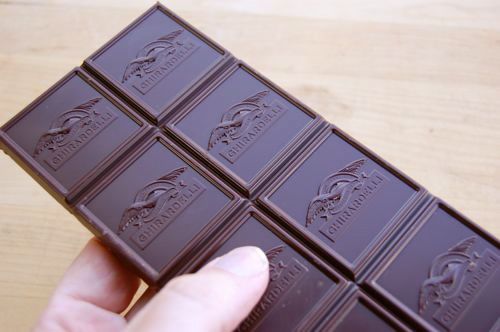How the pros do it.
Whenever you buy chocolate, it’s tempered. Bars, chips, disks, chunks…whenever chocolate leaves the factory, it’s tempered. The only time you’ll ever bring home untempered chocolate is if it’s been baked (say, in a chocolate chip cookie) or if you happen to leave it in a hot car and it melts. In either case, the carefully manipulated, uniform crystal structure is destroyed and a new, random one forms in its place — with the predictable consequences for the chocolate’s texture and appearance.
Here’s a factory-fresh chocolate bar that I’m about to melt down to make a chocolate coating. Notice the crisp definition around the logo emboss and the shiny luster of it. That almost gleaming surface is what happens when tempered chocolate is cooled in a metal or plastic mold. The already quite orderly cocoa butter crystals are given even more structure by their contact with a smooth surface, with the result that they reflect more light.

Compare that to the back side of the bar, which was exposed to the air as it cooled. It still has some luster, it’s not totally dull, however it has considerably less shine.

This is essentially the finish you can expect when you apply tempered chocolate to the top of a cake. And if you’ve ever wondered how it is that chocolates can be un-molded so easily without being reheated, it’s because tempered chocolate takes up 2-3% less space than untempered chocolate. All those tight crystal formations, donchaknow. The tempered bars thus loosen themselves from their molds as they cool.